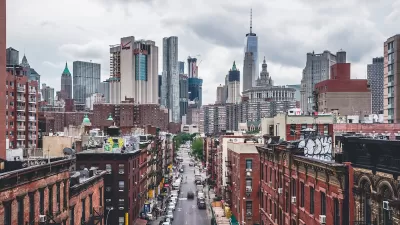Last summer, most of the nation was justifiably outraged when Raquel Nelson was convicted of vehicular homicide because her four-year old son stepped off a median into oncoming traffic and was killed. Common sense alone should have kept this case from going to trial, but I believe this case should have raised a bigger and more encompassing issue for planners and a question of social ethics: What is the responsibility we take as individuals for the choices we make living in an urban environment?
Last summer, most of the nation was justifiably outraged when Raquel Nelson was convicted of vehicular homicide because her four-year old son stepped off a median into oncoming traffic and was killed. Common sense alone should have kept this case from going to trial, but I believe this case should have raised a bigger and more encompassing issue for planners and a question of social ethics: What is the responsibility we take as individuals for the choices we make living in an urban environment?
Let me be quite clear that I'm not heaping blame on Raquel Nelson. As a parent, I've been in more than one situation similar to Ms. Nelson's where one mistake could have ended in tragedy (and I've actually stepped in to prevent similar tragedies). And also let me be clear that from what I know about the case (which is admittently limited to newspaper articles), I believe Ms. Nelson will bear more than her share of punishment for her responsibility for the incident, regardless of the legal outcome of the case.
Rather, I'm taking issue with some commentors from within the planning community who used the incident to blame urban design, transit operators, land-use regulators, traffic engineers, and others. David Goldberg, writing in the Washington Post (August 4, 2011), captured much of the outrage when he observed:
"Nelson was found guilty of killing her son by crossing the road in the "wrong" place. But what about the highway designers, traffic engineers, transit planners and land-use regulators who placed a bus stop across from apartments but made no provision whatsoever for a safe crossing? Those who ignored the fact that pedestrians always take the shortest possible route but somehow expected them to walk six-tenths of a mile out of their way to cross the street? Those who designed this road - which they allowed to be flanked by apartments and houses - for speeds of 50 mph and more? And those who designed the entire landscape to be hostile to people trying to get to work or carrying groceries despite having no access to a car? Are they not culpable?"
Another blogger in the planning community titled her commentary simply: When Design Kills.
I believe these criticisms are misplaced, largely because they presume that this particular incident could have been foreseen and prevented. This is a classic case of confusing what statisticians call "point probability" with "group probability." We can make predictions about general trends from patterns of data--and we use those to inform public policy and planning--but that doesn't mean we can predict when, where, and how certain incidents will occur. In the case of Raquel Nelson, better design could have improved the likelihood this accident wouldn't have occurred, but it couldn't have eliminated the possibility. Nor could anyone have stated with reasonable certainty that better planning and decign would have prevented the death. So, the short answer to David Goldberg's question is "no," the engineers, urban designers, builiders, etc. were not culpable in this death. Similar incidents could happen (and have happened) in crosswalks.
Living in an urban environment exposes us to risks and trade-offs on a daily basis. It's not like Ms. Nelson didn't have alternatives available to her. She could have chosen to walk with her children to the cross walk a half mile down the road; should could have chosen to live in another building on a road with less traffic; she could have chosen to take a taxi for the trip to the store to buy birthday presents for her children; she could have asked the other adults cross the street at the same time to help her with her children. The list of alternatives is long, if not endless.
Moreover, from the news reports, it's not at all clear that Ms. Nelson didn't take reasonable precautions even though she was jaywalking with several small children. Ultimately, she made a decision about the relative risks of the crossing the street at that particular moment with multiple children in tow. Perhaps she had done this successfully before. It's even possible that, like most of us, she had accomplished this task repeatedly before. These are the kinds of decisions that denizens of urban environments face on a daily basis. And the ugly truth is sometimes we're wrong, tragically wrong.
But what would a city be like without risk? Or uncertainty? In fact, one could argue that large, diverse, vibrant, urban places carry far greater everyday risks (including the likelihood of being hit in traffic, or by a bus, or by a train) because they are urban. Choice is fundamental to human existence, and one of the great virtues of cities is exposure to the wider ranges of opportunities and choices they provide. Choices also imply reponsibility for making them. Those risks and responsibilities should be acknowledged as an implicit component of urban life. Indeed, don't many planners criticize so-called sprawl because those communities attempt to purge all the diversity, risk, and vibrancy inherent in cities in the pursuit of safety, comfort, and banality?
And the world is never perfect. As planners we need to refrain from the trap of measuring the sometimes ugly realities of real life against the impossible standard of an ideal. Certainly, as transportation planners, we have an obligation and duty to design transit networks to maximize public safety and mobility. That likely includes making sure transit stops and locations are located properly (and it's not clear this was not the case in Marietta without knowing more details about travel patterns and ridership). As land-use planners (public and private) we need to consider the public health and safety demensions of projects. As developers, we need to consider safety and efficiency in designing access to our projects. But, this doesn't necessarily mean that we are culpable in accidents that lead to human tragedies. These duties and responsibilities, however, don't and can't include eliminating risk.
Design doesn't kill. It can create (or reduce) hurdles and barriers, and in the process alter our human calculations of risk and uncertainty, but it doesn't kill. In the end, we are left with individuals making decisions, the vast majority of which work out well, but occassionally end up in tragedy. As in Ms. Nelson's case, the consequences of making the wrong decision, on a particular day, at a particular moment, will be indelible. We don't necessarily need a prosecutor, or jury, or judge to recognize that.

Alabama: Trump Terminates Settlements for Black Communities Harmed By Raw Sewage
Trump deemed the landmark civil rights agreement “illegal DEI and environmental justice policy.”

Planetizen Federal Action Tracker
A weekly monitor of how Trump’s orders and actions are impacting planners and planning in America.

Why Should We Subsidize Public Transportation?
Many public transit agencies face financial stress due to rising costs, declining fare revenue, and declining subsidies. Transit advocates must provide a strong business case for increasing public transit funding.

Understanding Road Diets
An explainer from Momentum highlights the advantages of reducing vehicle lanes in favor of more bike, transit, and pedestrian infrastructure.

New California Law Regulates Warehouse Pollution
A new law tightens building and emissions regulations for large distribution warehouses to mitigate air pollution and traffic in surrounding communities.

Phoenix Announces Opening Date for Light Rail Extension
The South Central extension will connect South Phoenix to downtown and other major hubs starting on June 7.
Urban Design for Planners 1: Software Tools
This six-course series explores essential urban design concepts using open source software and equips planners with the tools they need to participate fully in the urban design process.
Planning for Universal Design
Learn the tools for implementing Universal Design in planning regulations.
Caltrans
Smith Gee Studio
Institute for Housing and Urban Development Studies (IHS)
City of Grandview
Harvard GSD Executive Education
Toledo-Lucas County Plan Commissions
Salt Lake City
NYU Wagner Graduate School of Public Service






























